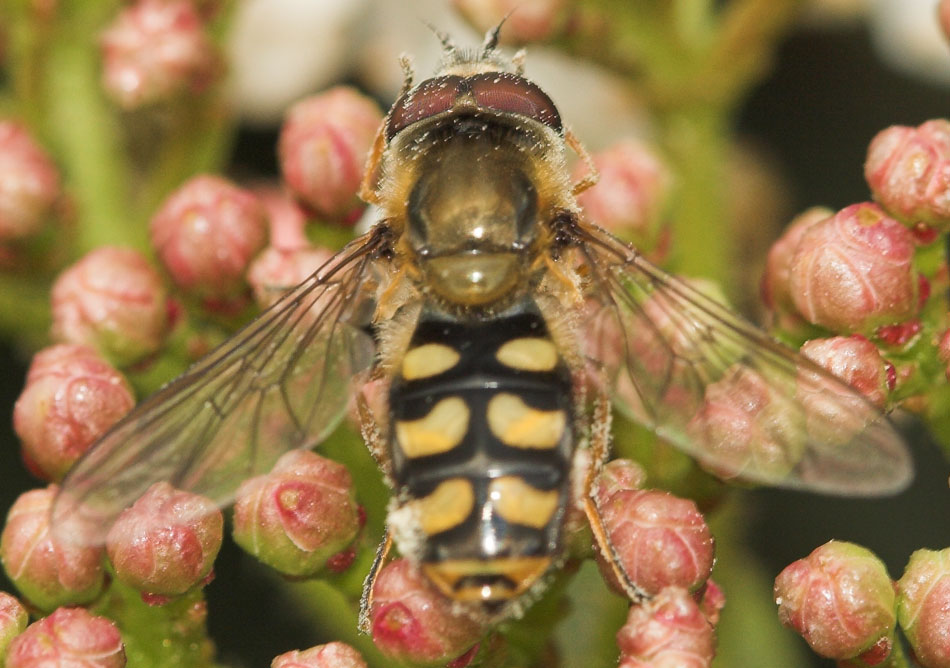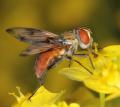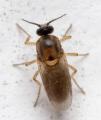Diptera.info :: Family forums :: Syrphidae
|
Dasysyrphus ?
|
|
| pierred |
Posted on 16-04-2006 08:41
|
|
Member Location: Paris (France) Posts: 1465 Joined: 21.04.05 |
Hello 3rd of April, 2006, 10-12 mm. I was thinking about Dasysyrphus. Lunulatus? Venustus? Thanks for any help. pierred attached the following image:  [122.14Kb] Pierre Duhem |
|
|
|
| lweit |
Posted on 16-04-2006 09:32
|
|
Member Location: France, Département de la Moselle Posts: 609 Joined: 23.12.05 |
I know Scaeva pyrastri pearheaps ?? |
|
|
|
| Gerard Pennards |
Posted on 16-04-2006 11:01
|
|
Member Location: Amersfoort Posts: 1914 Joined: 07.06.04 |
No, this is not a Dasysyrphus or Scaeva. This one is a male of Eupeodes luniger, which has broad yellow spots that do not (or just very narrowly) reach the side margin! Greetings,. Greetings, Gerard Pennards |
|
|
|
| Zeegers |
Posted on 16-04-2006 11:06
|
|
Member Location: Soest, NL Posts: 19086 Joined: 21.07.04 |
Hi Gerard, To quote the Spice Girls Are your really really sure ? To me, it is Eupeodes corollae, given the colouration on the thorax. In most / all other species, luniger included, the thorax is bluish-black, in any case much darker Theo Zeegers |
|
|
|
| Gerard Pennards |
Posted on 16-04-2006 11:31
|
|
Member Location: Amersfoort Posts: 1914 Joined: 07.06.04 |
Hoi Theo, Hmmm, yes I'm pretty sure this is luniger. The spots have a typical shape for luniger. Corollae males sometimes have spots that are not connected in the middle like in this picture, look for example at this: http://www.veluwe-insecten.nl/zweefvliegen/eupeodes/eupeodes.html But than the shape is still somewhat different. The next point (and the strongest I think) is that the males of corollae have a big genital knob, clearly distinguishable from above. In this picture we see (although a bit blurry) a male with a quite small genital knob, in corollae it would have been much bigger and broader in comparison with the size of the abdomen. So I still think this is luniger. The color you mention is maybe due to the angle of photographing and the use of flash or something like that! Greetings, Edited by Gerard Pennards on 16-04-2006 11:32 Greetings, Gerard Pennards |
|
|
|
| Zeegers |
Posted on 16-04-2006 16:56
|
|
Member Location: Soest, NL Posts: 19086 Joined: 21.07.04 |
Oke, you are really really sure. The colouration of the thorax is definitely misleading, but the photo has been flashed, so that might be the explanation. Thanks Theo |
|
|
|
| pierred |
Posted on 16-04-2006 17:55
|
|
Member Location: Paris (France) Posts: 1465 Joined: 21.04.05 |
Thanks to all of you. I showed you this picture, which is blurred, because one can see the body. I have another one, taken immediately after, where the wings were brought back on the body and hide it. Edited by pierred on 16-04-2006 17:57 Pierre Duhem |
|
|
|
| Jump to Forum: |












